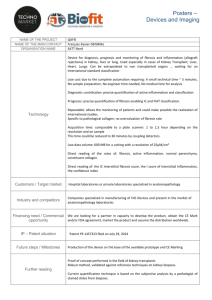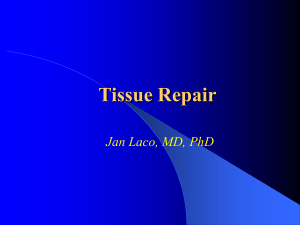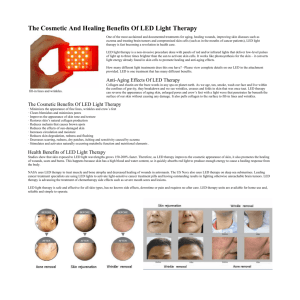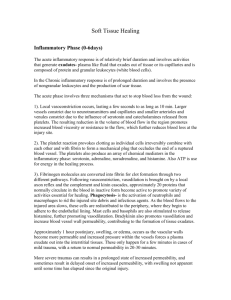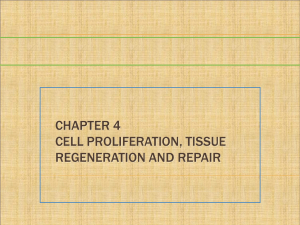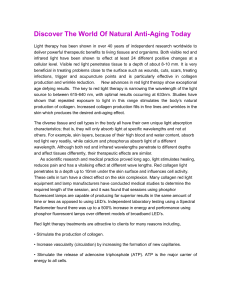Tissue Repair
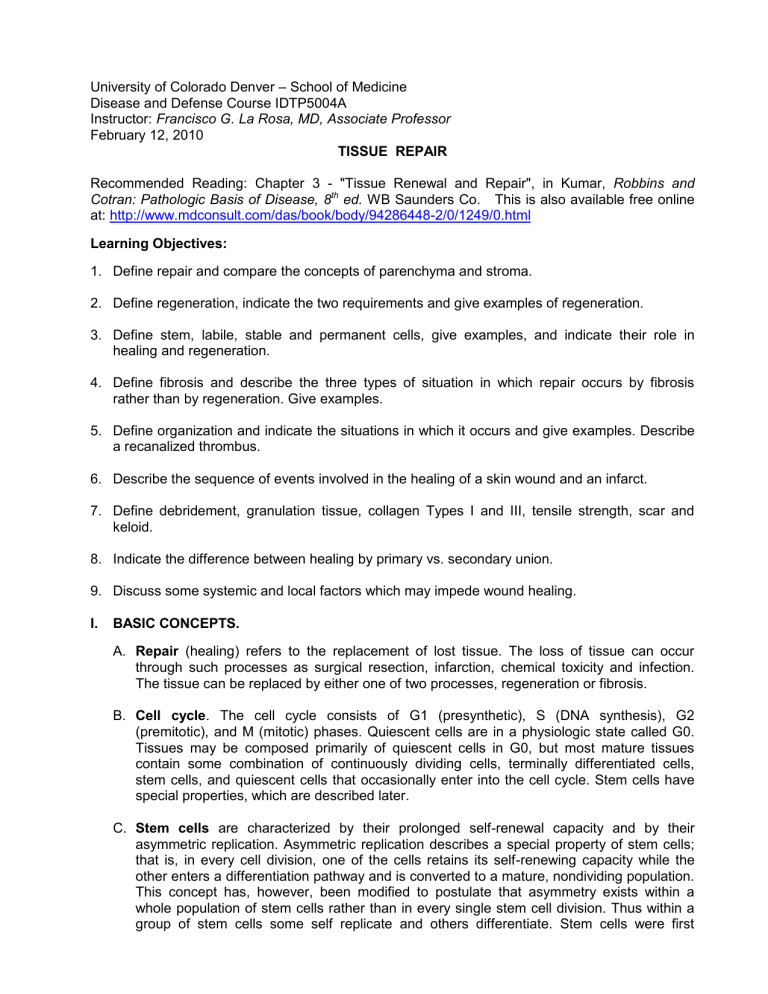
University of Colorado Denver – School of Medicine
Disease and Defense Course IDTP5004A
Instructor: Francisco G. La Rosa, MD, Associate Professor
February 12, 2010
TISSUE REPAIR
Recommended Reading: Chapter 3 - "Tissue Renewal and Repair", in Kumar, Robbins and
Cotran: Pathologic Basis of Disease, 8 th ed. WB Saunders Co. This is also available free online at: http://www.mdconsult.com/das/book/body/94286448-2/0/1249/0.html
Learning Objectives:
1. Define repair and compare the concepts of parenchyma and stroma.
2. Define regeneration, indicate the two requirements and give examples of regeneration.
3. Define stem, labile, stable and permanent cells, give examples, and indicate their role in healing and regeneration.
4. Define fibrosis and describe the three types of situation in which repair occurs by fibrosis rather than by regeneration. Give examples.
5. Define organization and indicate the situations in which it occurs and give examples. Describe a recanalized thrombus.
6. Describe the sequence of events involved in the healing of a skin wound and an infarct.
7. Define debridement, granulation tissue, collagen Types I and III, tensile strength, scar and keloid.
8. Indicate the difference between healing by primary vs. secondary union.
9. Discuss some systemic and local factors which may impede wound healing.
I. BASIC CONCEPTS.
A. Repair (healing) refers to the replacement of lost tissue. The loss of tissue can occur through such processes as surgical resection, infarction, chemical toxicity and infection.
The tissue can be replaced by either one of two processes, regeneration or fibrosis.
B. Cell cycle . The cell cycle consists of G1 (presynthetic), S (DNA synthesis), G2
(premitotic), and M (mitotic) phases. Quiescent cells are in a physiologic state called G0.
Tissues may be composed primarily of quiescent cells in G0, but most mature tissues contain some combination of continuously dividing cells, terminally differentiated cells, stem cells, and quiescent cells that occasionally enter into the cell cycle. Stem cells have special properties, which are described later.
C. Stem cells are characterized by their prolonged self-renewal capacity and by their asymmetric replication. Asymmetric replication describes a special property of stem cells; that is, in every cell division, one of the cells retains its self-renewing capacity while the other enters a differentiation pathway and is converted to a mature, nondividing population.
This concept has, however, been modified to postulate that asymmetry exists within a whole population of stem cells rather than in every single stem cell division. Thus within a group of stem cells some self replicate and others differentiate. Stem cells were first
Disease & Defense Block “Tissue Repair”
Page 2 identified as pluripotent cells in embryos, and these were called embryonic stem cells. It is now clear that stem cells are also present in many tissues in adult animals and contribute to the maintenance of tissue homeostasis.
D. Parenchyma - the key functional cell type(s) of a tissue or organ.
E xamples : Muscle cells in myocardium; hepatocytes in liver; neurons in brain.
E. Stroma - the supporting framework or interstitium of a tissue or organ.
II. GROWTH FACTORS
There is a large number of known polypeptide growth factors, some of which act on many cell types, and others have restricted cellular targets. In addition to stimulating cell proliferation, growth factors may also have effects on cell locomotion, contractility, differentiation, and angiogenesis, activities that may be as important as their growth-promoting effects. Here we review only those that have major roles in these processes.
A. Epidermal Growth Factor (EGF) and Transforming Growth Factorα (TGF-α) are two factors belonging to the EGF family and share a common receptor: a. EGF is mitogenic for a variety of epithelial cells, hepatocytes, and fibroblasts. It is widely distributed in tissue secretions and fluids, such as sweat, saliva, urine, and intestinal contents. In healing wounds of the skin, EGF is produced by keratinocytes, macrophages, and other inflammatory cells that migrate into the area. EGF binds to a receptor (EGFR) with intrinsic tyrosine kinase activity, triggering the signal transduction events described later. b. TGFα is involved in epithelial cell proliferation in embryos and adults and malignant transformation of normal cells to cancer. TGFα has homology with EGF, binds to
EGFR, and produces most of the biologic activities of EGF. The "EGF receptor" is actually a family of membrane tyrosine kinase receptors that respond to EGF, TGF-
α, and other ligands of the EGF family. The main EGFR is referred to as EGFR1, or ERB
B1. The ERB B2 receptor (also known as HER-2/Neu) has received great attention because it is overexpressed in breast cancers and is a therapeutic target.
B. Hepatocyte Growth Factor (HGF) has mitogenic effects in most epithelial cells, including hepatocytes and cells of the biliary epithelium in the liver, and epithelial cells of the lungs, mammary gland, skin, and other tissues. Besides its mitogenic effects, HGF acts as a morphogen in embryonic development and promotes cell scattering and migration. This factor is produced by fibroblasts, endothelial cells, and liver nonparenchymal cells. The receptor for HGF is the product of the proto-oncogene c-MET, which is frequently overexpressed in human tumors. HGF signaling is required for survival during embryonic development.
C. Vascular Endothelial Growth Factor (VEGF) is a potent inducer of blood vessel formation in early development (vasculogenesis) and has a central role in the growth of new blood vessels (angiogenesis) in adults. It promotes angiogenesis in tumors, chronic inflammation, and healing of wounds. VEGF family members signal through three tyrosine kinase receptors: VEGFR-1, VEGFR-2, and VEGFR-3. VEGFR-2 is located in endothelial cells and is the main receptor for the vasculogenic and angiogenic effects of VEGF. The role of VEGFR-1 is less well understood, but it may facilitate the mobilization of endothelial stem cells and has a role in inflammation. VEGF-C and VEGF-D bind to VEGFR-3 and act on lymphatic endothelial cells to induce the production of lymphatic vessels
(lymphangiogenesis). VEGF-B binds exclusively to VEGFR-1. It is not required for vasculogenesis or angiogenesis, but may play a role in maintenance of myocardial function.
Disease & Defense Block “Tissue Repair”
Page 3
D. Platelet-Derived Growth Factor (PDGF) is a family of several closely related proteins, each consisting of two chains designated A and B. All three isoforms of PDGF (AA, AB, and BB) are secreted and are biologically active. Recently, two new isoforms-PDGF-C and
PDGF-D-have been identified. PDGF isoforms exert their effects by binding to two cellsurface receptors, designated PDGFR α and β, which have different ligand specificities.47
PDGF is stored in platelet α granules and is released on platelet activation. It can also be produced by a variety of other cells, including activated macrophages, endothelial cells, smooth muscle cells, and many tumor cells. PDGF causes migration and proliferation of fibroblasts, smooth muscle cells, and monocytes, as demonstrated by defects in these functions in mice deficient in either the A or the B chain of PDGF. It also participates in the activation of hepatic stellate cells in the initial steps of liver fibrosis (Chapter 18). a) Fibroblast Growth Factor (FGF) is a family of growth factors containing more than 10 members, of which acidic FGF (aFGF, or FGF-1) and basic FGF (bFGF, or FGF-2) are the best characterized. FGF-1 and FGF-2 are made by a variety of cells. Released
FGFs associate with heparan sulfate in the ECM, which can serve as a reservoir for storing inactive factors. FGFs are recognized by a family of cell-surface receptors that have intrinsic tyrosine kinase activity. A large number of functions are attributed to
FGFs, including the following: New blood vessel formation (angiogenesis): FGF-2, in particular, has the ability to induce the steps necessary for new blood vessel formation both in vivo and in vitro (see below). b) Wound repair: FGFs participate in macrophage, fibroblast, and endothelial cell migration in damaged tissues and migration of epithelium to form new epidermis. c) Development: FGFs play a role in skeletal muscle development and in lung maturation.
For example, FGF-6 and its receptor induce myoblast proliferation and suppress myocyte differentiation, providing a supply of proliferating myocytes. FGF-2 is also thought to be involved in the generation of angioblasts during embryogenesis. FGF-1 and FGF-2 are involved in the specification of the liver from endodermal cells. d) Hematopoiesis:FGFs have been implicated in the differentiation of specific lineages of blood cells and development of bone marrow stroma.
E. TGF-
appears to be the most important growth factor in fibrosis. It induces fibroblast migration and proliferation, angiogenesis, and increased collagen and fibronectin production. Loss of TGFβ receptors frequently occurs in human tumors, providing a proliferative advantage to tumor cells.
II. REGENERATION
Regeneration is the process by which the lost tissue is replaced by cells/tissue identical to the original cells/tissue. This process requires:
A. A viable population of stem cells capable of dividing and differentiating into cells identical to those which were lost. Labile or stable cells.
B. A viable and intact stroma, including basement membrane.
Cell types with regard to normal renewal and regeneration:
A. Labile cells. These are continuously and rapidly replaced.
Examples : Surface epithelium of skin, G.I. tract, G.U tract, hematopoietic cells.
B. Stable cells. These are continuously but slowly replaced. Their proliferation can be markedly accelerated during regeneration.
Examples : Hepatocytes, renal tubular epithelial cells, endothelium, smooth muscle
Disease & Defense Block “Tissue Repair”
Page 4
C. Permanent cells: Although portions of these cells may be restored (e.g. neuron), the cells themselves are not replaced. Regeneration does not occur.
Examples : Skeletal and cardiac muscle, CNS neurons.
Examples of regeneration:
A. Replacement of hepatocytes after exposure to hepatotoxic chemicals or viral hepatitis.
B. Replacement of renal tubular epithelium after acute tubular necrosis or exposure to a nephrotoxic chemical.
C. Replacement of the mucosal epithelium in gastric erosion.
D. Replacement of epidermis in a first-degree burn.
III. FIBROSIS The lost tissue is replaced by fibrous connective tissue. Ultimately the fibrous connective tissue may become collagenized, i.e. converted to mature (Type I) collagen - a scar . Scar is virtually all dense collagen with few cells and vessels.
There are three situations in which repair occurs by fibrosis instead of regeneration.
A. Loss of permanent parenchymal cells.
Example : Myocardial infarcts heal by fibrosis and scar formation. This is due to the permanent nature of myocardial myocytes as well as the loss of stroma which occurs in an infarct regardless of location. Healing in the CNS does not involve fibrosis; rather, it occurs by gliosis.
This will be discussed in the neuropathology section of the course.
B. Loss of underlying stroma.
Example : Infarcts result in the loss of both parenchyma and stroma. Although the parenchymal cells of the kidney, lung and spleen are capable of regeneration, the loss of stroma precludes healing by regeneration.
C. Ongoing loss/destruction of parenchyma/stroma:
Example : The ongoing loss/destruction of parenchyma and stroma in alcoholic hepatitis cirrhosis, i.e. massive scarring of the liver.
Although some exudates, hemorrhage, thrombi and thromboemboli may undergo lysis and complete resolution, others may undergo organization, i.e. fibrosis leading to scar formation.
Examples :
1. Peritoneal pyogenic exudate secondary to a ruptured appendix, which undergoes organization into fibrous adhesions.
2. Organization of an exudate in pneumonia results in scar formation in the affected portion of lung (organized pneumonia).
3. A coronary artery thrombus which undergoes organization and scar.
4. When vascular channels form in the organizing thrombus, the tissue which had been perfused by the obstructed artery may be reperfused. This is the process of recanalization.
5. A subdural hematoma which organizes and forms a scar.
Sequence in fibrosis (timing is approximate and varies depending on the size of the area and other factors). This may occur, for example, as the healing of a skin wound or of a myocardial infarct.
A. Before fibrosis can occur dead tissue and any exudate or blood must be removed.
Phagocytic cells play a major role - neutrophils and macrophages ingest and lyse these materials. The manual removal of such material, especially of dead tissue, is debridement .
Disease & Defense Block “Tissue Repair”
Page 5
B. Ingrowth and proliferation of fibroblasts and endothelial (vascular) buds. The ingrowth and proliferation of vessels is known as angiogenesis. The fibroblasts produce “ground substance” - glycosaminoglycans and other extracellular matrix components, and then
Type III collagen - the pliable collagen which is present in embryonic and fetal tissues.
Macrophages continue to be present. This process occurs between 3 - 5 days; the tissue is granulation tissue .
C. By 10 - 14 days the removal of dead tissue is complete. Granulation tissue has replaced it and more collagen is being synthesized and secreted.
D. Increased amounts of intercellular collagen are laid down and immature collagen (Type III) is being replaced by dense, mature, high tensile strength collagen (Type I). This is accompanied by the replacement of fibroblasts and vessels. This occurs during the subsequent 6 weeks. Tensile strength refers to resistance to stretching.
E. At the end of 2 months repair is complete and the area has been converted to dense collagen - a scar - virtually devoid of cells and vessels. Scar achieves a maximal tensile strength of about 70% - 80% that of the original tissue.
The above sequence describes fibrotic repair as it occurs in many different sites. Healing of a cutaneous wound is some times described as healing by primary union vs. secondary union:
A. Primary unio n (healing by “first intention”) involves fibrosis within a wound the edges of which are apposed, e.g. by sutures.
B. Secondary union (healing by “secondary intention”). The defect is large. Wound contraction, accomplished by myofibroblasts, is necessary for repair to occur. If the defect is too large grafts may be necessary
Sometimes the scar exceeds the dimensions of the original tissue, e.g. a healed incision which protrudes above the surface of adjacent skin. This is a keloid . Blacks > Whites.
Factors which impede fibrosis:
A. Systemic - poor nutritional status (e.g. vitamin C deficiency, zinc deficiency), underlying disease (e.g. diabetes mellitus), certain medications (e.g. corticosteroids).
B. Localized - retention of dead tissue, foreign body, infection, reduced blood supply.
IV. TERMINOLOGY:
Angiogenesis
Collagen - Types I and III
Debridement
Organization
Parenchyma
Primary and secondary union
Fibrosis
Granulation tissue
Keloid
Labile, stable and permanent cells
Regeneration
Stroma
Scar
TGF-
Tensile strength
Review your notes and Kumar, et al on the normal biosynthesis and biology of collagen and such other extracellular matrix components as elastin, laminin, proteoglycans and fibronectin.
Disease & Defense Block “Tissue Repair”
Page 6
Disclaimers:
1. The primary goal of this chapter is to study the learning objectives outlined at the beginning of this handout. The material to study is provided in the lectures, the handouts and the recommended textbooks. All these sources provide the content over which you will be tested.
The lectures are intended to provide broad information of the material found in the textbooks and handouts, and to give the students the opportunity to ask questions on subjects not clear in the texts. The handouts do not seek to follow up the sequence of the lectures, and most importantly, they are not a surrogate of the books.
2. The text presented in this handout has been edited by Dr. La Rosa from material found in your books, from published articles and other educational works. This handout is solely for educational purpose and not intended for commercial or pecuniary benefit (see USA Copyright
Law, Section 110, “Limitations on exclusive rights: Exemption of certain performances and displays ”). Reproduction and use of this handout can be done only for educational use.
[ Download ] the USA Copyright Law version, October 2009.
